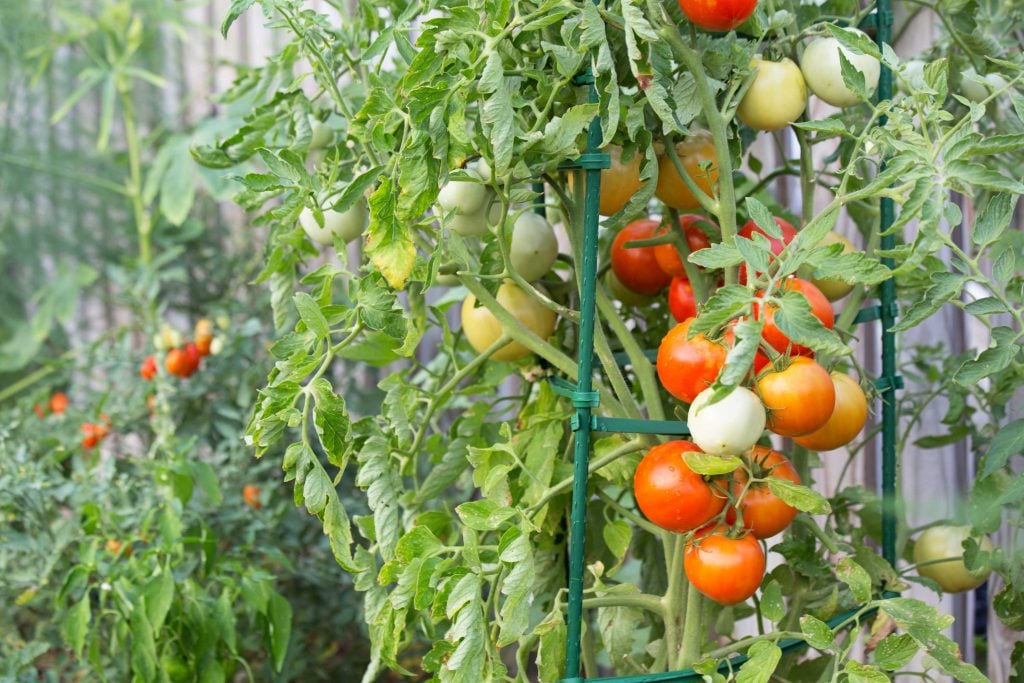Table of Contents
The herbaceous plant is native to temperate and tropical climates, but there is good news for garden enthusiasts living in frost-bound areas. Now you can always have cherry reds, round, large berries in your yard, round the clock.
As their name goes, the moneymaker tomatoes are unique and picture-perfect in shape and size. This sweet and sour berry has made its place in almost everyone’s palate, from health freak’s salad to Fridays with two pizzas!
With a wide range of advantages to these berries, the reasons to grow them in your garden have increased. Here are step-by-step SOPs that can be followed for a fruitful yield!
What Are Moneymaker Tomatoes?

Most cuisines have tomatoes as an integral part of their recipe. They add a fruity, bittersweet taste to even the blandest foods. It’s impossible to think of Italian meals without a tomato touch! These berries come in different shapes, sizes, and colours and can be used in edibles as per their taste.
It involves regular tomatoes, cherry tomatoes, beef tomatoes, etc. Out of these, Moneymaker tomatoes fulfill all the criteria, like perfect round shape, seamlessly red in colour, and tasty. Not only this, but these blended tomatoes have high yield capacity in comparison to their solanum fraternity.
Moneymakers are perennial plants that require adequate sunlight and moist soil even in colder regions, as they belong to a tropical climate. The Solanum family has a vast range of fruits and vegetables, including tomatoes, eggplant, and potatoes.
One feature that is common among them is they also come under the nightshades. Their prime characteristic in the fruit is that they possess alkaloids, which act as insecticides during their germination.
How to Grow Moneymaker Tomatoes at Home?
For greenskeepers, growing these hybrid tomatoes has been made a cakewalk by jotting down the exact and compact tips. This would encourage many of our readers that are novices in this field to try, experiment and begin their gardening journey with tomatoes.
Sowing the Seeds for Money Maker Tomato
- To begin sowing these moneymakers, pre-existing tomato slices can be used, or buying these seedsonline can also be considered.
- A container with drainage holes in the bottom; to avoid water logging should be used while planting the seeds. It is advised to use loose, well-draining soil along with a good potting mix that has a distinct ratio of organic matter; this would, in turn, boost the yield.
- The ideal condition to plant a moneymaker tomato seed is planting it at a depth of 70 to 80 cm from the surface, as it enhances the root strength and avoids stunting when the fruits appear.
After Sowing Caring Tips
- After sowing the seeds, a regular water shower is necessary to keep the soil moist and provide hydration to the seeds. As water plays a vital role in the germination stage and helps increase seed permeability.
- To uplift the growth, it is advised to feed the container with compost every 20 days. The ground must be properly prepared with nutrients to nourish tomato plants throughout the growing season, maximizing growth and fruit production.
- Tomato plants are deep-rooted heavy feeders and thrive in highly organic soils. The ideal ratio for the substratum is using 60% seed starting mix and 40% vermicompost and providing it with an ample amount of water.
- The most appropriate time to sow the seed is between January to May every year. After preparing the pot, keep it in partial shade till the seeds germinate.
- The container should be moved to a spot that has full sunlight. The germinated plants should be allowed to acclimatize in the sun every day for at least 6 to 8 hours, keeping the soil moist.
- A clear indication of transplanting the moneymakers outside in the garden is when the seedling attains a height of 7 to 8 inches, which takes at least one month from the time when the seeds were sown.
- It is advised to use the same soil composition as the initial one to avoid any damage to the established plant. Fertile, well-drained soil with ample organic matter and adequate water will help the plant recover from transplant shock.
Planting Money Maker Tomato
- For planting the moneymakers outside, a bigger container at least 18 inches deep with drainage holes or a smart grow bag is appropriate. With the help of any gardening tool, take the plants out of the small pot without damaging the roots.
- At a depth of 8 inches, plant them in the larger container. With the help of a pruner, remove the lower leaves and branches below the soil line. The deep plantation encourages a healthy root system.
- It is advised to cover the bottom of the container with potting soil, as tomatoes have the ability to sprout additional roots along the buried stem. These extra roots strengthen the plant so that it can support more fruit and avoid inhibition.
- Moneymakers should be watered in ample amounts after transplanting and allowed to be settled in the new environment. Keep the large containers in the shade for two days to let them recover from transplant shock.
- Gradually increase the sun exposure of the plants in the upcoming days. The suitable time to take the moneymakers outside is in June month, when there are the least chances of frost.
As you have been a routine reader on our page, you must have noticed that every seedling, before it is set to be planted outside, requires a cooling period, i.e., recovering from the transfer, outside temperature, natural, direct sunlight, uneven weather, soil, chances of attack from invasive species, pests, etc. Till the germination, it had been provided with the desired light, soil, and water, although it required care back then too. Moreover, the transplantation situation has a tendency to cause root damage, further leading to the loss of plants.
By the end of July month, small, round, green fruits will start to appear. At this time, it is advisable to use slow-releasing fertilizers to make sure every nook and corner receives nutrients and minerals for a healthy moneymaker tomato. These plants grow up to 1.5 meters in height, round and red when they bloom in September month.
How to Take Care of The Moneymaker Tomatoes?
As these tomatoes are hybrid from the rest tomatoes, it needs a particular set of caring tips. Here are a few tips that need to be executed while and after the growth of these round fruits.
Making Support for The Plants
Moneymaker requires a stake for support, just like the majority of tomato plants. The best materials are metal rods or even the branches of other plants, such as hazelnut bush. Moneymaker produces two to three shoots that grow well. When these shoots are established, make sure to regularly prune any extra side shoots that grow from the plant’s stem.
Providing Water and Nutrients on a Regular Basis
Although moneymakers can grow anywhere in the globe, it is necessary to provide regular water showers when they are sown and when they are planted outside. Along with that, soil that is moist, well-drained, and mildly acidic is the ideal substratum for the growth of tomatoes. Regular compost, soil setter, and slow-releasing fertilizer induction are very helpful in the growth process.
Maintenance
In almost all your garden trials and experiments, beginning from the pot to the yard, a keen eye on every bud is very necessary. A little bit of effort every day can help yield bright and big fruits. These tomatoes will generate an abundance of green growth, some blooms, and scant amounts of usable fruit if left to their own ways in the British climate, but with constant care, your plants will continue to produce tomatoes until early October. When using the cordon growing technique, the plant is trained on a single stem, tied to a cane, and all side shoots that begin to grow in between the stem and leaves are cut off. Plants will start to flower shortly with lots of sunshine and regular tomato feed dressings.
Conclusion
After following these growing and caring tips, many garden enthusiasts have achieved successful results. Not only can you grow these tomatoes from the pre-existing ones, but you can also freeze them for a longer time to enjoy their taste all through the year.
Share your experiences and garden experiments on our page and get a chance to avail free garden equipment coupon.
Subscribe to our page and get tips in crux!
Frequently Asked Questions
How Long Do Moneymaker Tomatoes Take to Grow?
From seed to first harvest, a crop of Moneymaker tomatoes takes roughly 16 weeks, depending on whether you are growing in a greenhouse or outdoors. While seeds can be sown in a heated greenhouse as early as late December, it is more typical to do so in an unheated greenhouse or on the kitchen window sill in March or April for planting in April or May.
What Types of Tomatoes Are Moneymakers?
MoneyMaker is cultivated as a cordon-style tomato. This means the moneymakers can be cultivated on single-stemmed vines, and they are trained to produce more tomatoes, along with preventing side shoots from developing smears. The more pruning is carried out on these tomatoes, the more optimum growth is seen. However, if left without any pruning, it will still produce lots of fruits but slightly smaller and delayed from the actual season.
What Size Are the Moneymaker Plants?
A well-maintained and grown moneymaker can reach up to 1.8 to 2 meters of height. Moneymaker plants have a two-meter height limit and can yield 10 fruits per vine. These tomatoes mature to a deep red colour and weigh about 100 grams. The Moneymaker variety is a medium-early one, and you can often start harvesting it at the end of July.





